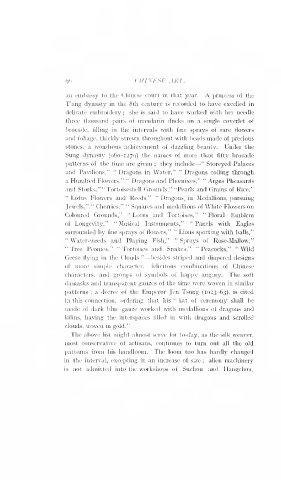Page 334 - Chinese Art, Vol II By Stephen W. Bushell
P. 334
t)6 CHINESE ART.
an embassy to the Chinese court in that year. A jjrincess of the
T'ang dynasty in the 8th century is recorded to have excelled in
delicate embroidery ; she is said to have worked with her needle
three thousand pairs of mandarin ducks on a single coverlet of
brocade, filling in the intervals with line sprays of rare flowers
and foliage, thickly strewn throughout with beads made of precious
stones, a wondrous achievement of dazzling beauty. Under the
Sung dynasty (960-1279) the names of more than fifty brocade
—
patterns of the time are given they include " Storeyed Palaces
;
and Pavihons," " Dragons in Water," " Dragons coiling through
a Hundred Flowers," " Dragons and Phoenixes," " Argus Pheasants
and Storks," " Tortoiseshell Grounds," "Pearls and Grains of Rice,"
" Lotus Flowers and Reeds," " Dragons, in Medallions, pursuing
Jewels," " Cherries," " Squares and medallions of White Flowers on
Coloured Grounds," " Lotus and Tortoises," " Floral Emblem
of Longevity," " Musical Instruments," " Panels with Eagles
surrounded by line sprays of flowers," " Lions sporting with balls,"
" Water-weeds and Playing Fish," " Sprays of Rose-Mallow,"
" Tree Peonies," " Tortoises and Snakes," " Peacocks," " Wild
"
Geese flying in the Clouds —besides striped and diapered designs
of more simple character, felicitous combinations of Chinese
characters, and groups of symbols of happy augury. The soft
damasks and transparent gauzes of the time were woven in similar
patterns ; a decree of the Emperor Jen Tsung (1023-63), is cited
in this connection, ordering that his " hat of ceremony shall be
made of dark blue gauze worked with medallions of dragons and
kilins, having the interspaces filled in with dragons and scrolled
clouds, woven in gold."
The above list might almost serve for to-day, as the silk weaver,
most conservative of artisans, continues to turn out all the old
patterns from his handloom. The loom too has hardly changed
in the interval, excepting in an increase of size alien machinery
;
is not admitted into the workshops of Suchou and Hangchou.

